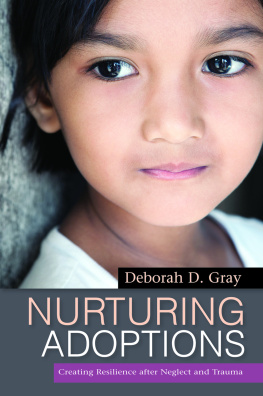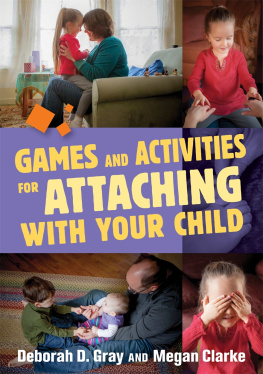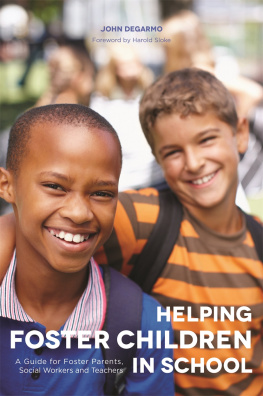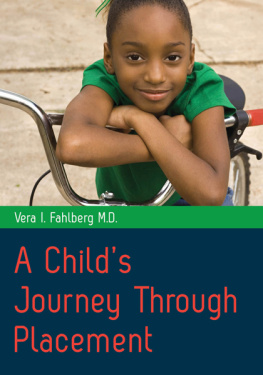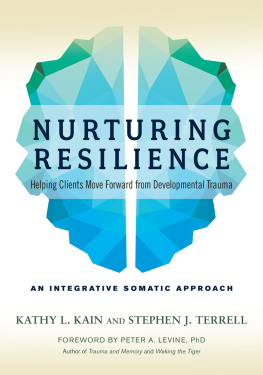
Nurturing Adoptions
Creating Resilience after
Neglect and Trauma
Deborah D. Gray

Jessica Kingsley Publishers
London and Philadelphia
C H A P T E R 1
 The Changing Nature of Adoption
The Changing Nature of Adoption
A doption, both domestic and international, has changed dramatically in just one generation. Increasing numbers of children enter new homes after having experienced trauma and neglect in families or in orphanages throughout the world. Trauma and neglect are not adoption issues by themselvesindeed they are pre-adoption issuesbut they are of special interest to the adoption community because of their prevalence in todays adopted children. In the same way that triad issues were of special interest thirty years ago, resulting in new and developing literature at that time, issues stemming from early maltreatment undergirds modern, developing adoption literature.
Domestic Adoption in the
Early 21 st Century
According to a 2006 report by the North American Council on Adoptable Children, about 140,000 children are adopted in the United States annually. About 10% of these children were infants whose parents made voluntary adoption plans. Semi-open or fully disclosed adoptions are more common than confidential adoptions (NACAC, 2006).
Contrast these numbers with 1970s adoptions, when there were 172,000 children adopted in the United States. Almost all were infants whose parents made confidential, voluntary adoption plans. There were few children adopted after trauma and neglect, since adoptees were mostly newborns.
Since the 1970s AFCARS Reporting shows that the rate of newborn adoption has dropped steadily, while the adoption rate from foster care has surged. AFCARS, or the Adoption and Foster Care Analysis and Reporting System, is a federal data collection effort that provides child-specific information on all children covered by the protections of Title IV-B and Title IV-E of the Social Security Act. On an annual basis, all states submit data to the U.S. Childrens Bureau, concerning each child in foster care and each child who has been adopted under the authority of the states child welfare agencies. The AFCARS databases have been designed to address adoption and foster care policy development and program management issues at both the state and federal levels. About 50,000 children were adopted from foster care in 2003. The reporting of final numbers comes in slowly, but statistical sampling shows that that level seems to be holding steady. The average age of children being adopted from foster care in 2003 was 7.0 years and the median age was 6.1 years. Showing public policy commitment and hard work on the part of social workers, that number had climbed from 36,000 children adopted from substitute care in 1998. Of the children adopted from the foster care system, 87% qualified for a special needs assistance package.
There were 119,000 children waiting in foster care to be adopted in the United States in 2006. Their average age was 8.6 years, and the median was 8.7 years old. Today the number of children waiting for adoption is at a relatively steady level, with one child becoming legally free for adoption as another one child is adopted (AFCARS, 2006, pp. 3-10).
While poly-drug and alcohol abuse have always been issues for child welfare, the successive epidemics of cocaine, crack cocaine, and methamphetamines have escalated the rates of severe maltreatment in young children. Children, as a group, are entering the foster care system with more serious neglect than in generations past.
International Adoption in the Early 21 st Century
There have been similarly dramatic changes in international adoption. About 23,000 children were adopted internationally in 2005. The number of internationally adopted children has tripled over the previous fifteen years.
These selected years show the trends in the number of international adoptions in the United States.
Table 1-1
Number of Children Adopted to the U.S. from Other Countries by Fiscal Year |
FY 1990 | FY 2000 | FY 2004 | FY 2005 |
7,093 | 17,718 | 22,884 | 22,728 |
During this same period, the countries of origin have also shifted.
Table 1-2
Top Six Countries from Which Children Were Adopted to the United States |
FY 1990 | FY 2005 |
2,620 Korea | 7,906 China |
631 Columbia | 4,639 Russia |
440 Peru | 3,783 Guatemala |
421 Philippines | 1,630 Korea |
348 India | 755 Kazakhstan |
302 Chile | 441 Ethiopia |
International adoptions, like domestic adoptions, show a trend towards children being adopted later in infancy/childhood. However, internationally adopted children, as a group, are markedly younger than children adopted from foster care. Of the total children internationally adopted, 10,113 children were between 1 and 4 years old and 3,537 were older than 5 years old. (The differences in the manner in which statistics were collected do not allow for an average age.) Additionally, the gender differences were remarkable, with about two girls adopted to every boy (U. S. Department of Homeland Security, 2007).
There are uncertainties about how the international Hague Convention Treaty guidelines and the 2007 implementation of those guidelines under rules set by the United States may impact the numbers of children coming to the U.S. through international adoption. The House of Representatives Hearings on International Adoption Guidelines held on November 14, 2006 revealed that agencies were quickly preparing for the new regulations (Barry, Scialabba, 2006). The trend towards adoption from countries without a tradition of family foster care and with third world health conditions continues.
Changes in Adoptive Families in the Early 21st Century
During this same period there have been substantial changes in adoptive parents. Social changes are prompting people to build families later. There is an increase in treatment options for older women, so that couples adopting due to infertility are significantly older than they were a generation ago. The rate of divorce and second marriages as well as the related increase in the age differential within married couples means that it is not uncommon for one or both potential adoptive parents to be in their late 40s and up to late 50s. Sometimes there are much older half siblings connected to very young adopted siblings.
Age can contribute to whether singles or couples choose to adopt independently as opposed to from private agencies, whether they choose to adopt internationally as opposed to domestically, and, when adopting internationally, can influence from which country they choose to adopt.
About 80% of families who adopt internationally do so after infertility (AFCARS, 2006). Families who are adopting internationally are building families. They will look at another option if opportunities for international adoption dip because of changes in the international guidelines. The probable result is that the number of families adopting domestically from foster care is likely to increase if international adoption opportunities decrease. About half of two-parent families adopting from foster care are doing so after issues of infertility. And, half of the parents adopting older children are first-time parents (AFCARS Report, 2006).
Next page
